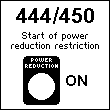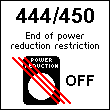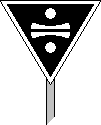Section 18: Signs in Electrified Areas
(Page 3 of 4)
In 2004, work was under way to upgrade the traction power supply between Earlswood and Three Bridges. In the event of an electrical disruption occurring while this work was taking place, it was necessary for drivers of Class 375 and 377 'Electrostar' units to drive in Notch 2 through the affected substation area. When these circumstances applied, temporary signs were displayed at the beginning and end of the affected area. The commencement sign had the legend "375/7" above "Notch 2", on a blue inverted triangle [18.40]. The termination sign was similar but had a white diagonal band superimposed [18.41]. In certain locations, one sign applied to the tracks on either side, indicated by arrows pointing left and right [18.42 & 18.43].
 |
 |
[18.40] 'Notch 2' Commencement Sign.
Area: Southern Region
Usage: Low
Status: Historical
|
[18.41] 'Notch 2' Termination Sign.
Area: Southern Region
Usage: Low
Status: Historical
|
 |
 |
[18.42] 'Notch 2' Commencement Sign.
Area: Southern Region
Usage: Low
Status: Historical
|
[18.43] 'Notch 2' Termination Sign.
Area: Southern Region
Usage: Low
Status: Historical
|
Later in 2004, signs similar to [18.40 - 18.42] were provided in connection with power supply upgrade work between Herne Hill and Sydenham Hill. These signs applied to 'Electrostar' units of Classes 375 and 376, and therefore had the legend "375/6" at the top.
|
Later neutral section warning boards installed on the CTRL match the equivalent signs used on the French railways and differ slightly from the style previously provided on the CTRL (see [18.37]). The legend at the top of the newer signs is an abbreviation of 'sectionnement à', which is French for 'sectioning at' [18.44].
|
 |
[18.44] Warning Sign for Neutral Section (e.g. 1000 metres ahead).
Area: CTRL
Usage: Medium
Status: Current
|
|
|
On the CTRL, a diagonal white sign with two concentric blue squares [18.45] denotes a location where the overhead catenary wire ends. Electric trains must not pass without the pantograph first being lowered. Several railways in continental Europe use a similar sign for the same purpose.
|
 |
[18.45] 'Limit of Electric Traction' Sign.
Area: CTRL
Usage: Unknown
Status: Current
|
|
|
The newer style of "section gap" board installed on the DC electrified lines in the Liverpool area had an upright shape [18.46] in contrast to the wide shape of the original boards (see [18.5]).
|
 |
[18.46] "Section Gap" Board.
Area: Liverpool area
Usage: Medium
Status: Historical
|
|
From December 2009 until January 2010, while engineering work was taking place in the Southampton area (Wessex Route), drivers of Class 444 and 450 'Desiro' units were required to drive under power reduction conditions. Special temporary signs were displayed at each entrance to [18.47] and exit from [18.48] the affected area.
 |
 |
[18.47] Class 444/450 Power Reduction Restriction Commencement Sign.
Area: Southampton
Usage: Low
Status: Historical
|
[18.48] Class 444/450 Power Reduction Restriction Termination Sign.
Area: Southampton
Usage: Low
Status: Historical
|
Drivers of electric trains may be required to engage 'Power Reduction Mode' (PRM) or drive in Notch 2 because of a problem with the electric traction supply. As part of a trial on the Wessex Route, the start and end points of affected areas may be marked by temporary signs. The commencement sign is in the form of a train class specific notice board (see [26.20]) with the legend "electric trains" at the top and the letters "PR" in the middle [18.49]. The termination sign bears a red diagonal cross in the manner of a train class specific 'no entry' sign (see [25.38]) with the letters "PR" superimposed on its centre [18.50].
 |
 |
[18.49] Power Reduction Mode Commencement Sign.
Area: Wessex Route
Usage: Medium
Status: On Trial
|
[18.50] Power Reduction Mode Termination Sign.
Area: Wessex Route
Usage: Medium
Status: On Trial
|
In August 2011, new rules were introduced to permit electric trains to coast at high speed, with their pantographs lowered, through a section where the power to the overhead line equipment has been isolated because of damage, power failure or planned engineering work. Temporary 'lower pantograph' and 'raise pantograph' signs (see [18.23 & 18.25]) will be provided at the beginning and end of the affected section. In addition, an 'advance lower pantograph' sign with two flashing white lights [18.51] will be placed about 400 metres on the approach to the 'lower pantograph' sign, and a 'do not raise pantograph' sign [18.52] will be placed beyond the 'raise pantograph' sign. If the pantograph has not been raised by the time the train reaches the 'do not raise pantograph' sign, the pantograph must not be raised until the speed of the train has been reduced to 20 mph. Before allowing an electric train to approach an affected section, the signalman will verbally advise the driver that high-speed coasting is taking place.
 |
 |
[18.51] 'Advance Lower Pantograph' Sign.
Area: All Areas
Usage: Medium
Status: Historical
|
[18.52] 'Do Not Raise Pantograph' Sign.
Area: All Areas
Usage: Medium
Status: Current
|
Some of the Class 80x trains are electro-diesel ("multi-mode") units that can switch from electric to diesel traction and vice versa while running at speed (known as a 'dynamic' power changeover). These power changeovers are performed either manually or automatically. From 2017, signage was introduced at manual power changeover sites, the first of these being located between Taplow and Maidenhead on the Great Western Main Line. The first sign, in either direction, warns drivers of the approach to the traction changeover zone and is of the standard design (see [18.22]). The driver should select "coast" on the train's power controller. For a changeover from electric to diesel traction, the warning sign is followed by a Class 80x specific notice board with the word "diesel" (see [26.20]) at the start of the changeover zone, beyond which is a 'lower pantograph' sign with a subsidiary plate reading "Class 80x" (see [18.24]), at the point by which the pantograph must be lowered. In the opposite direction, a 'raise pantograph' sign (see [18.26]) marks the start of the changeover from diesel to electric traction. Beyond this is a 'do not raise pantograph' sign (see [18.52]). If the driver has not commenced the traction changeover process by the time the train reaches this sign, changeover must not be attempted until speed has been reduced to under 20 mph. Apart from the 'lower pantograph' sign, no lineside signs are provided at an automatic dynamic power changeover site.
In 2018, new signs were introduced for use at neutral sections of the longer carrier wire type on the Great Western Main Line, the first of which were located between Maidenhead and Ruscombe. The signs denoting the approach to and start of a long neutral section were the same as the standard neutral section boards (see [18.19 & 18.20]), but they also carried a supplementary sign underneath with the word "long" [18.53 & 18.54]. Another sign, with a red diagonal cross [18.55], denoted the end of a long neutral section. Most of these signs were removed in 2021/2022 and replaced by standard neutral section boards.
 |
 |
 |
[18.53] Long Neutral Section Warning Board.
Area: Great Western Main Line
Usage: Medium
Status: Obsolescent
|
[18.54] Long Neutral Section Indication Board.
Area: Great Western Main Line
Usage: Medium
Status: Obsolescent
|
[18.55] 'End of Neutral Section' Sign.

Area: Great Western Main Line
Usage: Medium
Status: Obsolescent
|









